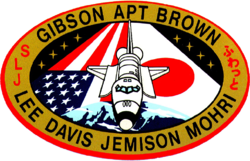Mamoru Mōri
| Mamoru Mōri | |
|---|---|
 | |
| Land: | Japan |
| Organisation: | NASDA |
| ausgewählt am | 7. August 1985 |
| Einsätze: | 2 Raumflüge |
| Start des ersten Raumflugs: | 12. September 1992 |
| Landung des letzten Raumflugs: | 22. Februar 2000 |
| Zeit im Weltraum: | 19d 4h 09m |
| ausgeschieden am | Dezember 2000 |
| Raumflüge | |
Mamoru Mōri (jap.毛利 衛, Mōri Mamoru; * 29. Januar 1948 in Yoichi, Hokkaidō, Japan; in den USA bekannt als Mamoru „Mark“ Mohri) ist ein ehemaliger japanischer Astronaut. Er war Teilnehmer zweier Space-Shuttle-Missionen der NASA.
Mōri wurde auf Japans Nordinsel Hokkaidō geboren, ist mit der von der gleichen Insel stammenden Akiko Naka verheiratet und hat drei Kinder.
Mōri studierte an der Universität Hokkaidō Chemie und erwarb 1970 einen Bachelor sowie zwei Jahre später einen Master. Danach ging er nach Australien und absolvierte bis 1976 ein Doktorat in Chemie an der Flinders University in Adelaide. Bis 1985 arbeitete er ein Jahrzehnt lang wieder an der Universität Hokkaidō: er forschte und lehrte an der Kerntechnischen Fakultät, brachte es bis zum außerordentlichen Professor und arbeitete auf den Gebieten Oberflächenchemie, Hochenergiephysik und der Halbleiterentwicklung.
Mōri wurde im August 1985 von der damaligen japanischen Raumfahrtagentur NASDA als Nutzlastspezialist ausgewählt. Zusammen mit Takao Doi und Chiaki Mukai bereitete er sich für den ersten Spacelab-Flug unter japanischer Federführung vor. Die Spacelab-J-Mission sollte ganz im Zeichen der Werkstoffforschung stehen und trug deshalb auch die Bezeichnung „First Materials Processing Test“ (FMPT).
Mōri wurde 1990 zum Teilnehmer der Mission STS-47 berufen, mit der er 1992 erstmals ins All flog. Durch seine Auftritte als Lehrer im „Weltraumklassenzimmer“ während der Mission kam er zu großer nationaler Bekanntheit. 2000 nahm Mōri als leitender Nutzlastspezialist an der Mission STS-99 teil.
Derzeit ist Mōri Leiter des Zukunftsmuseums Miraikan in Tokio.
Weblinks
- Biografie von Mamoru Mōri in der Encyclopedia Astronautica (englisch)
- Kurzbiografie von Mamoru Mōri bei spacefacts.de
| Personendaten | |
|---|---|
| NAME | Mōri, Mamoru |
| ALTERNATIVNAMEN | 毛利 衛 (japanisch); Mōri Mamoru; Mark Mohri |
| KURZBESCHREIBUNG | japanischer Astronaut |
| GEBURTSDATUM | 29. Januar 1948 |
| GEBURTSORT | Yoichi |
Auf dieser Seite verwendete Medien
STS099-(S)-001 (JUNE 1999) STS-99 INSIGNIA -- The crew members designed the flight insignia for the Shuttle Radar Topography Mission (SRTM), the most ambitious Earth mapping mission to date. Two radar antennas, one located in the Shuttle bay and the other located on the end of a 60-meter deployable mast, will be used during the mission to map Earth's features. The goal is to provide a 3-dimensional topographic map of the world's surface up to the Arctic and Antarctic Circles. The clear portion of Earth illustrates the radar beams penetrating its cloudy atmosphere and the unique understanding of the home planet that is provided by space travel. The grid on Earth reflects the mapping character of the SRTM mission. The patch depicts the Space Shuttle Endeavour orbiting Earth in a star spangled universe. The rainbow along Earth's horizon resembles an orbital sunrise. The crew deems the bright colors of the rainbow as symbolic of the bright future ahead because of human beings' venturing into space.
The mission emblem of STS-47 depicts the Space Shuttle Orbiter with the Spacelab module in the cargo bay against a backdrop of the flags of the United States and Japan, symbolizing the side-by-side cooperation of the two nations in this mission. The land masses of Japan and Alaska are represented on the emblem emphasizing the multi-national aspect of the flight as well as the high inclination orbit of 57 degrees. The initials `SLJ' on the left border of the emblem stand for Spacelab Japan, but the name generally used for the mission is `Spacelab-J.' The Japanese characters on the right border form the word `Fuwatto' which is the Japanese word for weightlessness.
Official portrait of Japanese astronaut; Mamoru Mohri. This photo was for the STS-99 Shuttle Mission in 2000 CE. Astronaut Mamoru Mohri, mission specialist representing Japan's National Space Development Agency (NASDA).


